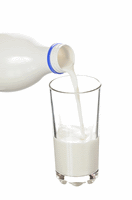Food Groups - Dairy
Food Groups Continued...This group is often called the milk group.
It includes milk products as well as products made from milk.
Cheeses, yogurts and milk based desserts are part of the dairy group.
In order to qualify as a food item in this group it must retain it's calcium content when made from milk.
Items like cream cheese and butter do not qualify for this group.
This group is represented by a circle in the MyPlate graphic. This illustrates a glass of milk included with your meal.
However, you will often get your milk items in through foods and not a drink.
Dairy
 All
fluid milk products and many foods prepared with milk are included in
this food group.
All
fluid milk products and many foods prepared with milk are included in
this food group.Calcium fortified soy milk is also part of this group.
If a food item made from milk retains the calcium content, then it is included in this group,
However, items that have little or no calcium content are not part of this group. Items like cream cheese, cream and butter are not part of the dairy food group.
You want to aim for fat free or reduced fat products for this food group to minimize fat and calories.
Here are some examples of items in the category.
| Milk Fat Free Milk Reduced Fat Milk (1% and 2%) Whole Milk Flavored Milk (chocolate, strawberry, etc.) Lactose Milks Calcium Fortified Soymilk Milk Based Desserts Puddings Ice Cream Frozen Yogurt Ice Milk |
Cheese Hard Natural Cheeses (cheddar, mozzarella, swiss, parmesan) Soft Cheese (ricotta, cottage cheese) Processed Cheeses (American) Yogurt Fat Free Yogurt Low Fat Yogurt Reduced Fat Yogurt Whole Milk Yogurt |
While this food group is not part of the plate in the image, you can get your servings through a glass of milk or items that can be placed on your plate like cheeses or yogurts.
Here are the recommended daily servings for the dairy group.
Yogurt - 1 regular container (8 oz) would be equivalent to 1 cup. A snack size container (4 oz) = 1/2 cup and a small container (6 oz) = 3/4 cup.
Cheese - 1 1/2 oz hard cheese, 1/3 cup shredded cheese, 2 oz processed cheese, 1/2 cup ricotta cheese and 2 cups cottage cheese would be equivalent to 1 cup serving.
Milk Based Desserts - 1 cup of pudding or frozen yogurt would be a 1 cup dairy serving. 1 1/2 cups of ice cream would be the equivalent to 1 cup serving.
Here's more on the recommended portion sizes based on the food pyramid food groups.
Additional Articles
Fruitfully
Cheesy Kabobs
Get in two of the different food groups with this fun and tasty recipe. Alternating different cheeses and fruits give this snack lots of
different flavors.
Tips for
Eating Healthy
Use these tips to build your plate into a healthy meal. Eating healthy can ensure you get all the vitamin and minerals your
body needs.
Fat
Burning Foods
Get your daily recommended dairy, fruits, veggies and more with these
foods. Not only are you getting the recommended amounts, you will burn more fat
with these foods.
